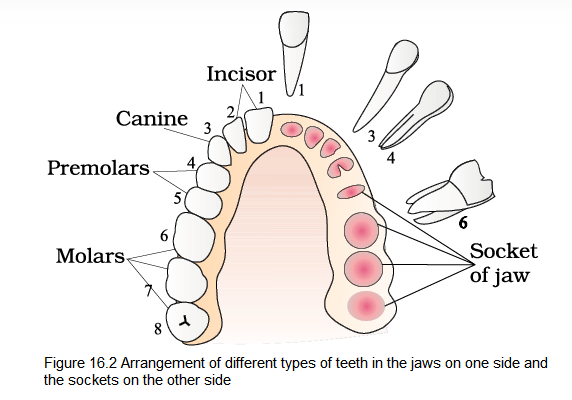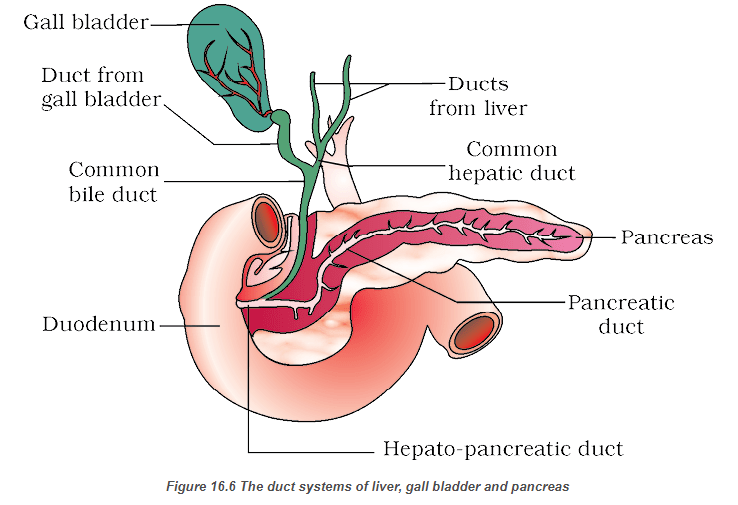16.1 Digestive System
The human digestive system consists of the alimentary canal and the associated glands.
Alimentary Canal
The alimentary canal begins with an anterior opening – the mouth, and it opens out posteriorly through the anus.
Mouth
- The mouth leads to the buccal cavity or oral cavity. The oral cavity has a number of teeth and a muscular tongue. Each tooth is embedded in a socket of jaw bone (Figure 16.2). This type of attachment is called thecodont.
- Majority of mammals including human being forms two sets of teeth during their life, a set of temporary milk or deciduous teeth replaced by a set of permanent or adult teeth. This type of dentition is called diphyodont.
- An adult human has 32 permanent teeth which are of four different types (Heterodont dentition), namely, incisors (I), canine (C), premolars (PM) and molars (M).
- Arrangement of teeth in each half of the upper and lower jaw in the order I, C, PM, M is represented by a dental formula which in human is 21232123.
- The hard chewing surface of the teeth, made up of enamel, helps in the mastication of food.
- The tongue is a freely movable muscular organ attached to the floor of the oral cavity by the frenulum. The upper surface of the tongue has small projections called papillae, some of which bear taste buds.
- The oral cavity leads into a short pharynx which serves as a common passage for food and air. The oesophagus and the trachea (wind pipe) open into the pharynx.
- A cartilaginous flap called epiglottis prevents the entry of food into the glottis – opening of the wind pipe-during swallowing.

Stomach
- Stomach is the widest organ of the alimentary canal. The oesophagus is a thin, long tube which extends posteriorly passing through the neck, thorax and diaphragm and leads to a ‘ J ‘ shaped bag like structure called stomach. A muscular sphincter (gastro-oesophageal) regulates the opening of oesophagus into the stomach.
- The stomach, located in the upper left portion of the abdominal cavity, has four major parts:
- A cardiac portion into which the oesophagus opens,
- a fundic region,
- body (main central region) and
- a pyloric portion which opens into the first part of small intestine (Figure 16.3).
- Both the cardiac and pyloric ends of the stomach are guarded by sphincters (cardiac and pyloric respectively), which regulate the entry and exit of food in and out of the stomach.
- The opening of the stomach into the duodenum is guarded by the pyloric sphincter.
- Stomach helps in mechanical churning and chemical digestion of food. It also acts as food reservoir.

Small intestine
- Small intestine is distinguishable into three regions, a ‘ C ‘ shaped duodenum, a long coiled middle portion jejunum and a highly coiled ileum. It averages approximately 6 m in length, extending from the pyloric sphincter of the stomach to the ileo-caecal valve.
- Duodenum is the proximal C-shaped region that serves a mixing function as it combines digestive secretions from the pancreas and liver with the contents expelled from the stomach. The start of the jejunum is marked by a sharp bend, the duodenojejunal flexure. The final portion, the ileum, is the longest coiled segment and empties into the caecum at the ileo-caecal junction.
- Small intestine completes digestion of proteins, carbohydrates, fats and nucleic acids. It also absorbs nutrients into the blood and lymph.
Large intestine
- The ileum opens into the large intestine. It consists of caecum, colon and rectum. It has a length of approximately 1.5 m and a width of 7.5 cm.
- Caecum is a small blind sac which hosts some symbiotic micro-organisms. A narrow finger-like tubular projection, the vermiform appendix which is a vestigial organ, arises from the caecum. The caecum opens into the colon.
- The colon is divided into four parts – an ascending, a transverse, descending part and a sigmoid colon. The descending part opens into the rectum which opens out through the anus.
- Colon is concerned with conservation of water, sodium or other minerals and formation of faeces. The descending colon opens into the rectum which opens out through anus.
The chief function of large intestine is the absorption of water and the elimination of solid waste.
Histology of Alimentary Canal
- The wall of alimentary canal from oesophagus to rectum possesses four layers (Figure 16.4) namely serosa, muscularis, sub-mucosa and mucosa.
- Serosa is the outermost layer and is made up of a thin mesothelium (epithelium of visceral organs) with some connective tissues.
- Muscularis is formed by smooth muscles usually arranged into an inner circular and an outer longitudinal layer. An oblique muscle layer may be present in some regions.
- The submucosal layer is formed of loose connective tissues containing nerves, blood and lymph vessels. In duodenum, glands are also present in sub-mucosa.
- The innermost layer lining the lumen of the alimentary canal is the mucosa. This layer forms irregular folds (rugae) in the stomach and small finger-like foldings called villi in the small intestine (Figure 16.5).
- The cells lining the villi produce numerous microscopic projections called microvilli giving a brush border appearance. These modifications increase the surface area enormously.
- Villi are supplied with a network of capillaries and a large lymph vessel called the lacteal.
- Mucosal epithelium has goblet cells which secrete mucus that help in lubrication. Mucosa also forms glands in the stomach (gastric glands) and crypts in between the bases of villi in the intestine (crypts of Lieberkuhn). All the four layers show modifications in different parts of the alimentary canal.

Digestive Glands
The digestive glands associated with the alimentary canal include the salivary glands, the liver and the pancreas.

Gastric glands
- Saliva is mainly produced by three pairs of salivary glands, the parotids (cheek), the submaxillary/sub-mandibular (lower jaw) and the sub-linguals (below the tongue). These glands situated just outside the buccal cavity secrete salivary juice into the buccal cavity.
- Peptic cells or chief or zymogenic cells are usually basal in location and secrete gastric digestive enzymes as proenzymes; pepsinogen and prorennin. They also secrete small amount of gastric amylase and gastric lipase.
- Oxyntic cells or parietal cells are the most numerous cells on the side walls of the gastric glands. They are called parietal cells as they lie against the basement membrane. They secrete hydrochloric acid (HCl) and Castle’s intrinsic factor.
- Mucous cells or goblet cells are present between other types of cells and secrete mucus. Mucus is a glycoprotein and helps to neutralise the acid in stomach and protects stomach wall against HCl action and protein digestive enzymes.
Liver
- Liver is the largest gland of the body weighing about 1.2 to 1.5 kg in an adult human. It is situated in the abdominal cavity, just below the diaphragm and has two lobes.
- The hepatic lobules are the structural and functional units of liver containing hepatic cells arranged in the form of cords. Each lobule is covered by a thin connective tissue sheath called the Glisson’s capsule.
- The bile secreted by the hepatic cells passes through the hepatic ducts and is stored and concentrated in a thin muscular sac called the gall bladder. The duct of gall bladder (cystic duct) along with the hepatic duct from the liver forms the common bile duct (Figure 16.6).
- The bile duct and the pancreatic duct open together into the duodenum as the common hepato-pancreatic duct which is guarded by a sphincter called the sphincter of Oddi.
Pancreas
- The pancreas is a compound (both exocrine and endocrine) elongated organ situated between the limbs of the ‘ C ‘ shaped duodenum. The exocrine portion secretes an alkaline pancreatic juice containing enzymes and the endocrine portion secretes hormones, insulin and glucagon.
- The pancreas is a heterocrine gland i.e., partly exocrine and partly endocrine. The exocrine part of the pancreas consists of rounded lobules (acini) that secrete an alkaline pancreatic juice with pH 8.4.
- The endocrine part of the pancreas consists of groups of islets of Langerhans. Each of islets of Langerhans consists of three types of cells: alpha cells (secrete hormone glucagon), beta cells (secrete hormone insulin) and delta cells (secrete hormone somatostatin).